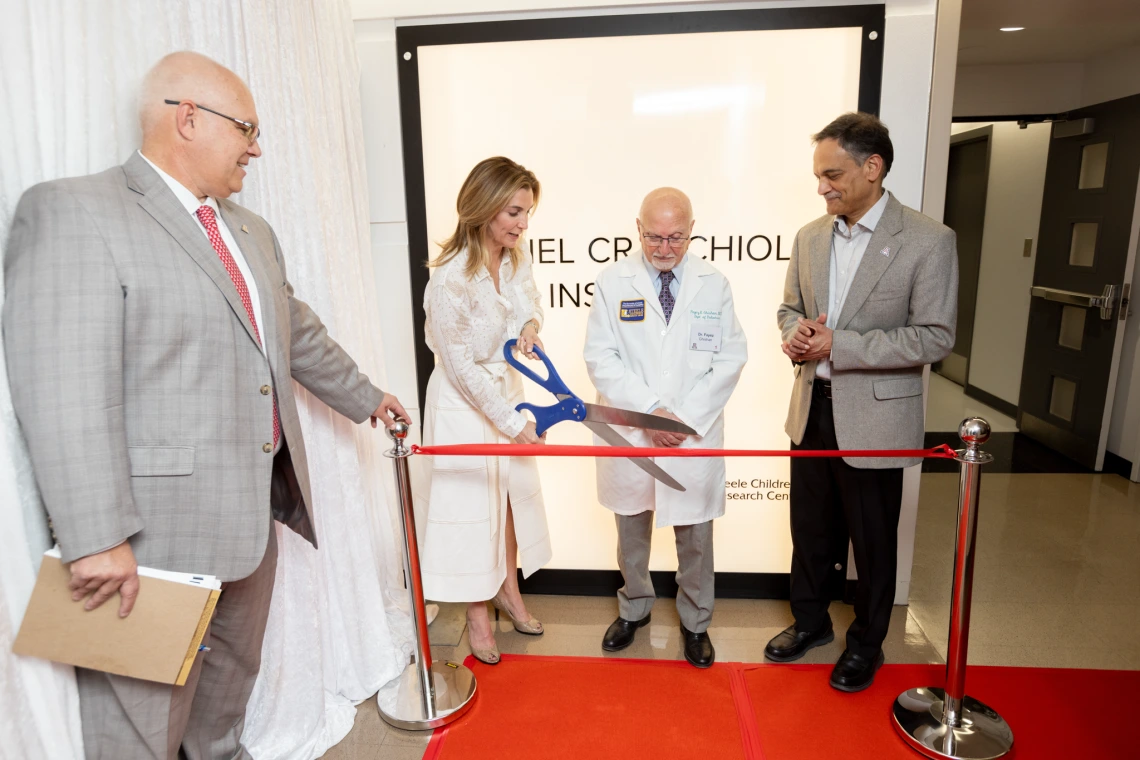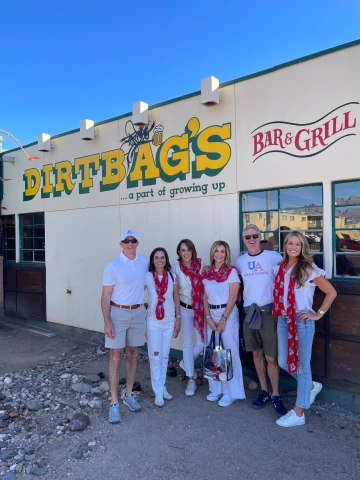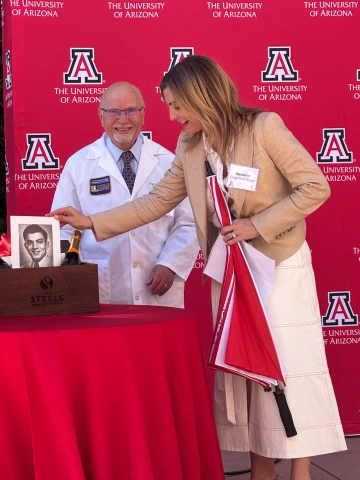U of A Made: Marianne Cracchiolo Mago
A conversation with alumna Marianne Cracchiolo Mago about her Wildcat roots, giving back and honoring her father’s vision.

Marianne Cracchiolo Mago and her father Dan Cracchiolo
Allison Tyler Jones Photography
Marianne Cracchiolo Mago ’93 reflects warmly on her years at the University of Arizona — moving into Coronado when it was an all-female dorm, pledging Gamma Phi Beta and wading in the Old Main fountain. Her formative college experiences, and the friendships they forged, instilled in her the confidence to “go for it.” After graduating, she landed a role as Jon Stewart’s personal assistant in New York, eventually rising to become senior vice president of comedy development at Warner Bros. Television Studios.
Fifteen years later, she stepped away from Hollywood and returned to Phoenix to accept what her father, Dan Cracchiolo ’52, called a “gift.” Dan, co-founder of the law firm Burch & Cracchiolo and founder of the Steele Foundation — a nonprofit supporting underserved children in Arizona — invited her to carry forward his philanthropic legacy as president. “I know you think this is just a job,” he told her, “but you’ll see — this work is the greatest gift.”
It didn’t take long for her to understand. “Giving back is contagious,” she says. “It impacts your life, your children, your community. It’s also humbling work. Philanthropy is a great privilege.”
Since Dan’s passing in 2022 at age 93, Marianne has overseen Steele’s largest-ever gift: a $10 million investment in the University of Arizona’s Steele Children’s Research Center, establishing the Daniel Cracchiolo Institute for Pediatric Autoimmune Disease Research.
The Institute celebrated its official opening with a ribbon cutting ceremony in February. The grant established the institute and endowed the Daniel Cracchiolo Endowed Chair for Pediatric Autoimmune Disease Research as well as the Pamela Grant Endowed Professorship and the Fayez K. Ghishan, MD Endowed Professorship. Steele also included a specific fund to support graduate students and postdoctoral researchers.
Now serving as co-chair of the Fuel Wonder campaign, the university’s $3 billion fundraising initiative, Marianne sees this role as deeply personal — almost a return to her roots. After all, her father’s childhood home once stood near the University of Arizona Foundation building on Speedway and Cherry. Her journey has come full circle, transforming formative college experiences into a lifelong commitment to giving back and inspiring future generations.

Marianne Cracchiolo Mago, Fayez Ghishan and Suresh Garimella at the Daniel Cracchiolo Institute for Pediatric Autoimmune Disease Research ribbon cutting.
Chris Richards
What are some of your favorite memories from the U of A?
I viscerally remember moving down from Phoenix into Coronado dorm. In those days, it was all girls. I remember Spring Fling. I remember formals. I remember what it felt like to walk to class on the Mall. It was chaotic and fun. You’d see all sorts of activities and people enjoying themselves in the beautiful weather.
Being on the Mall, crisscrossing campus, is something that, to this day, when I go back, I’m just like, “Oh, I remember taking this or that shortcut.” Back in the day, there’d even be reggae bands set up there. That was our meeting place and the center of campus. It made you so happy that you went to school in beautiful Arizona.
What’s this we hear about the fountain in front of Old Main?
I think it was frowned upon, but occasionally we went late-night swimming in the fountain. It was a bit gross and freezing but it was a blast — though I wouldn’t recommend it to students today.

Marianne Cracchiolo Mago with sorority sisters outside Dirtbag’s during Homecoming 2023.
Cracchiolo Mago
How did Gamma Phi Beta shape your U of A experience?
It was like a rite of passage to live in that house. I met people who were raised all over the country in different families and in different ways. And it was a microcosm. No matter how many sororities say their brand is this or that, it’s a group of 150 girls living together, and you’re going to get a little bit of everything. You also experience communal living — we all slept on a sleeping porch and endured work duty for an eight-month long pledge-ship. I remember phone duty, writing down paper messages from inside our phone booth, chapter meetings, rush week and “TG’s.” We spent so much time together. It helped me grow up and, at the same time, gave me a sense of home on a very big campus. I ate breakfast, lunch and dinner there for my first two years. In my day, there were still 40,000 kids at U of A, so Gamma Phi was a great home base to regroup and then head back out onto campus.
How did your U of A relationships influence you?
Being at U of A in the early ’90s was an incredible time. The people I met were the most easygoing, happy, fun and down-to-earth. And you take the feeling of that community with you when you’re in your 20s, trying to cobble together a career, and you’re lonely in a city — the experience of making those connections and the niche I carved out helped me in my life and in my career. I will tell you, moving back to Arizona many years later, after leaving and having a family of my own, running into so many fantastic alums just makes me smile. I am so proud of the connection we share.
I have a string of texts with five or six of my old girlfriends — we were literally texting last night. I don’t think you realize how lucky you are in college until it is in the rearview mirror. When we all got out of school, we relied on each other even though we were scattered across the country, and one girlfriend was in Europe. My friendships gave me courage and confidence in my 20s. It made me a better person, made me a better early professional — and it has made me a better mom knowing these women. We leaned on each other as we forged ahead and developed careers. You get to feed off people who know everything about you, have your back, and who you trust.
Which lessons unexpectedly helped you later in life?
I don’t know how my friends talked me into being pledge trainer, but my senior year of college I oversaw about 35 18-year-old girls. I was so overwhelmed to be responsible for those young women. I took them through an eight-month curriculum. I had a lot of late-night knock-knock-knocks and teary-eyed women at my door. It was more challenging than I had thought possible, but the experience was great. No doubt about it, it helped me with my teenage girls later in life.

Fayez Ghishan and Marianne Cracchiolo Mago showcasing her father’s U of A graduation photo from 1952.
Chris Richards
You shifted careers from television to philanthropy. How has your work at the Steele Foundation changed you?
I’ve learned to see through other people’s eyes, which has enriched my life and shaped how I parent. There are moments when Steele’s philanthropy really hits me — like supporting low-income students from Brophy College Preparatory who became the first in their families to graduate college. Watching them graduate and meeting their parents can be overwhelming — in those moments, it is a powerful reminder of how education can transform a family. It’s a stark reminder of my father’s experience and all I have been blessed with in my life.
What is it that appeals to you about working in the nonprofit sector?
At Steele, we invest in nonprofit leaders that are top of their game and who Arizona must support to remain in this challenging sector. We invest to help grow their capacity and strengthen their business models. Unlike private businesses with resources at their fingertips, nonprofits must fundraise for essentials like business plans, consultants and databases. We’re here to help bridge that gap and realize their impact with our grantmaking.
Your father’s motto was “Give a damn.” What did he mean by that?
My dad was a first-generation college graduate and worked very hard through high school and college. He had a lot of pressure on his shoulders from his father, who I think maybe had an eighth-grade education. So, my dad really sized people up by their passion and work ethic. That was the most important thing in his life. My grandfather spoke in broken English, and he would say the most important things in life are “love, economy and morality.” He would list those qualities on his fingers as he would tell us. (I had no idea what “morality” was at seven years old, but I was like, “All right, we’ll take your word for it.”) It’s how my dad was raised. To give a damn about your quality of work, where you’re headed and what you’re going to do for your family and the community.
What qualities have become important to you as you’ve forged your own path?
I don’t know about you, but the older I get, the more I realize I have pretty good instincts and I should follow them. Your gut instinct is one of the most important things to guide you as you navigate this world, as you raise children, as you chart a career path — all you have are your instincts. I fear sometimes one can be tempted to ignore their gut instincts.
How did your father inspire you to become a Fuel Wonder campaign co- chair?
My father passed away in June 2022, but before that, he had encouraged me to join the board of the University of Arizona Foundation. A few months after his passing, we established an endowed chair in his name, and I was determined to cement his namesake on campus. Working with the U of A Foundation during that time was an incredibly meaningful experience. My development officer, Clint McCall, who has since retired, supported me through some of the saddest days of my life, helping turn a difficult time into something truly beautiful. So, when JP Roczniak asked me if I would co-chair the Fuel Wonder campaign, the decision was easy. Through my work with the Steele Foundation, I had seen firsthand the impact of major giving, and I wanted to help raise funds for the university I love so much.
Has your relationship with the university changed over the years?
Dramatically. After about 20 years of building your life after college, you start to feel a shift, and soon you have time to reinvest in all your relationships again. And one of those old relationships is with the U of A. Now, I can attend homecomings, reconnect with old friends and get involved. Most of our kids are getting older now, and our careers are established, giving us the freedom to come full circle and spend a little time where it all began.
Knowing what you know now, what advice do you have for students of today?
Know your audience and tailor your approach accordingly. Generation X doesn’t need more emails — we appreciate handwritten notes. And don’t be afraid to pick up the phone. I tell my employees this all the time, but they hesitate. I just say, “Pick up the phone — it’ll save you about 15 emails!”
Do you have a Wildcat love story?
My husband, James, is also a U of A alum. Thankfully, we didn’t meet in college — who knows if we’d be married! We met in L.A. when I was 28 and he was 30, introduced by a fellow Wildcat at a U of A vs. UCLA basketball game. In L.A., we had a little community of alums we loved, and it helped make a big city feel much smaller.
Did U of A win the game?
I don’t remember. That’s such a good question. It was in 1998. My husband would probably remember. I just remember how cute my husband was. I just kept thinking, “Where has he been?”



